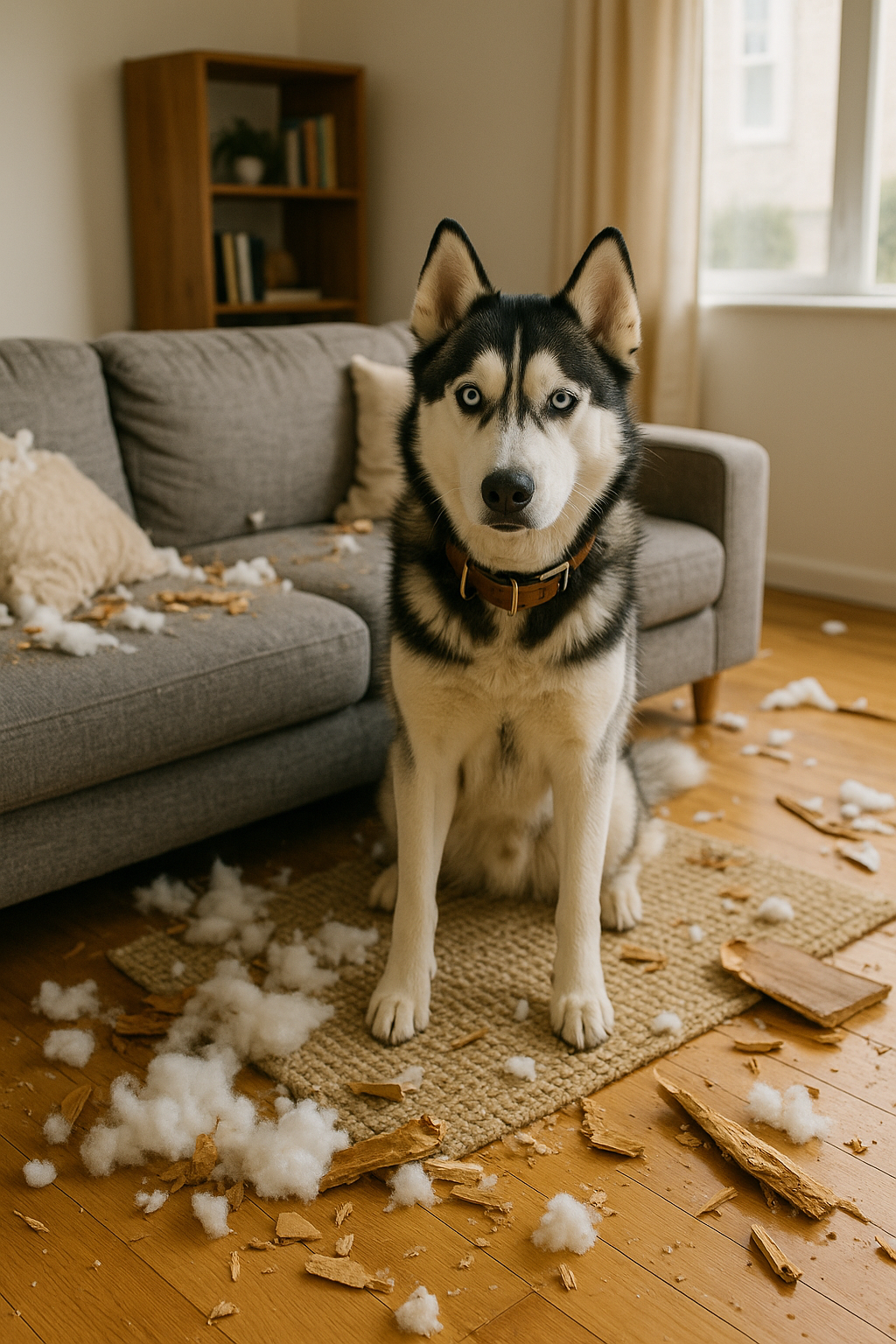Living with a Siberian Husky in an apartment can feel like trying to contain a snowstorm in a shoebox. They’re high-energy, smart, and easily bored—which means if you’re not careful, your furniture, walls, and floors might become targets for their frustration.
The good news? With the right strategy, you can prevent your Husky from tearing your apartment apart. This article will guide you through simple, effective ways to manage energy, reduce destruction, and keep your living space (mostly) intact.
Why Huskies Destroy Things Indoors
Before you can fix the behavior, you have to understand the cause. Destruction is rarely about “bad behavior.” It’s usually a sign that something is missing.
Common reasons Huskies destroy things:
- Boredom
- Lack of physical exercise
- No mental stimulation
- Separation anxiety
- Inconsistent boundaries
- Undertrained impulse control
Once your Husky learns that tearing up a pillow is fun and relieves stress, it can quickly become a habit—unless you step in with better options.
Step 1: Drain Energy First Thing in the Morning
A Husky left alone with too much energy is a recipe for disaster. Give them a serious energy outlet before you leave for the day.
- Go for a long walk or jog (30–45 minutes)
- Do a training session with commands or tricks
- Play tug, fetch, or scent games
- Let them run in a secure area (if available)
Tired Huskies nap. Energetic Huskies redecorate with their teeth.
Step 2: Use Enrichment Toys While You’re Gone
Mental stimulation is key. Leave your Husky with puzzle toys that challenge their brain and keep their mouth busy.
Try:
- Frozen KONGs filled with peanut butter or yogurt
- Snuffle mats with hidden kibble
- Treat-dispensing puzzle balls
- Durable chew toys like Benebone or Nylabone
Rotate toys every few days to prevent boredom.
Step 3: Designate a Safe, Dog-Proofed Space
Instead of giving them free access to the entire apartment, set boundaries.
- Use baby gates to block off tempting areas
- Choose a room with tile or wood flooring
- Remove shoes, cords, and anything they might chew
- Set up a cozy bed, water, and safe toys
- Consider a crate (only if properly crate-trained and not used as punishment)
Make this space a positive retreat, not a punishment zone.
Step 4: Use a Camera to Monitor Behavior
Dog cameras let you check in while you’re at work. You can:
- Watch for signs of anxiety or boredom
- Speak to your Husky (some models have two-way audio)
- Drop treats remotely as a reward for calm behavior
If you see destructive behavior starting, you can redirect it before it gets worse.
Step 5: Train Calm Indoor Behavior
Don’t just prevent bad behavior—teach good behavior.
Train commands like:
- “Go to bed” for settling on their mat
- “Leave it” for off-limits items
- “Quiet” for barking or howling
- Impulse control games like “stay” and “wait”
Use treats, praise, and consistency. The calmer they are inside, the safer your furniture will be.
Step 6: Don’t Make Leaving or Returning a Big Deal
If you hype up your departure or arrival, your Husky may develop anxiety around it.
- Ignore your dog for 10 minutes before leaving and after returning
- Don’t say long goodbyes or excited hellos
- Let calm behavior be the standard
This helps your Husky understand that being alone is normal—not something to panic over.
Step 7: Offer Midday Breaks if Possible
Long days alone increase the risk of destruction. Try to:
- Hire a dog walker
- Ask a neighbor or friend to check in
- Use doggy daycare once or twice a week
- Come home on lunch breaks if your schedule allows
Even a 15-minute break can reduce stress and energy build-up.
Step 8: Keep a Predictable Routine
Huskies love structure. Set a daily routine for:
- Walks
- Meals
- Playtime
- Rest time
- Training or enrichment
A consistent routine helps them feel safe—and less likely to act out.
Step 9: Avoid Harsh Punishments
Scolding, yelling, or physical punishment doesn’t work on Huskies. It can damage trust and make the problem worse.
Instead:
- Redirect with a command and a toy
- Reward good behavior
- Prevent access to problem areas
- Stay calm and patient
Focus on teaching, not punishing.
Final Thoughts: You Don’t Need a Yard—You Need a Plan
Yes, Huskies are energetic. Yes, they’re prone to chaos. But they’re also incredibly trainable, loyal, and adaptable—with the right structure.
By combining physical exercise, mental enrichment, safe spaces, and consistent training, you can absolutely live in peace with a Husky—even in a small apartment.
Because when their needs are met, your Husky won’t need to chew your couch to tell you how they feel.
